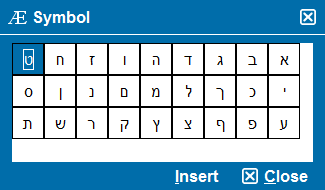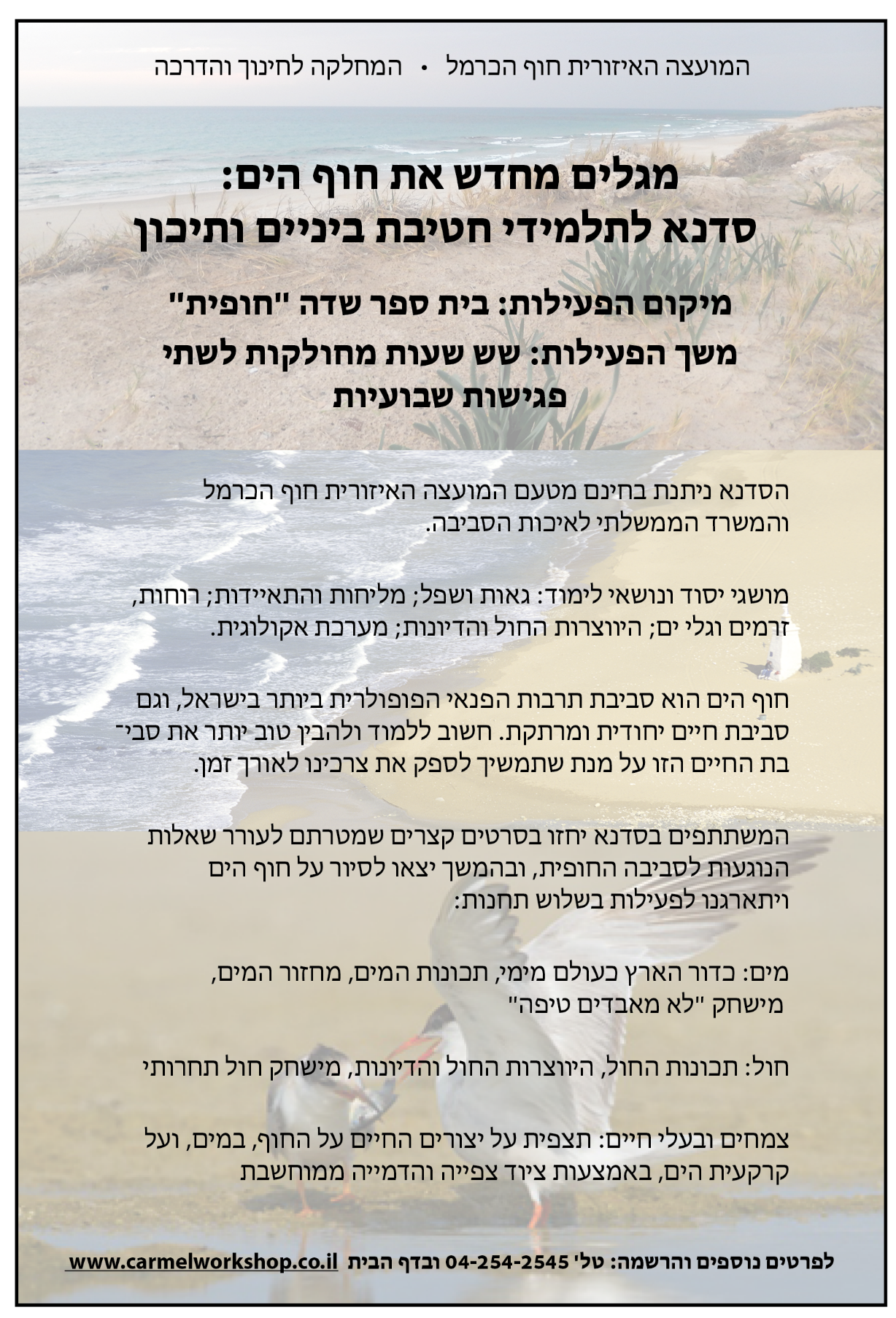Study Guide
Field 124: Hebrew CST
Pedagogical Content Knowledge
Recommendation for individuals using a screenreader: please set your punctuation settings to "most."
Review the
character selector tutorial video
![]() and the
special character palette available for the Hebrew CST:
and the
special character palette available for the Hebrew CST:
Directions for Pedagogical Content Knowledge Assignment
For the Pedagogical Content Knowledge section of the test, you will write a response of approximately 400 to 600 words start bold in English end bold to an assignment.
Read the assignment carefully before you begin to write. Think about how you will organize your response. You should use your time to plan, write, review, and edit your response to the assignment. Your final response must be typed in the on-screen response box presented with the assignment.
Please note that Hebrew characters will be available for insertion in the on-screen response box. To access these characters, click on the
button that appears in the upper left corner of the screen. Using the mouse, double-click on the character you wish to include in your response, or click on the character and then select " start bold Insert end bold ." The character will be inserted where the cursor is positioned in the response box.
Your response will be evaluated according to the following criteria:
- start bold COMPLETENESS: end bold The degree to which the response addresses all parts of the assignment
- start bold ACCURACY: end bold The degree to which the response demonstrates the relevant knowledge and skills accurately and effectively
- start bold DEPTH OF SUPPORT: end bold The degree to which the response provides appropriate examples and details that demonstrate sound reasoning
Your response will be evaluated on the criteria above, not writing ability. However, your response must be communicated clearly enough to permit valid judgment of your knowledge and skills. Your response must be your original work, written in your own words, and not copied or paraphrased from some other work.
Be sure to write about the assigned topic. Remember to review what you have written to ensure that you address all aspects of the assignment and make any changes you think will improve your response.
Select the start bold Next end bold button to continue.
Sample Pedagogical Content Knowledge Assignment
Competency 0005
Pedagogical Content Knowledge
start bold Use the information below and the exhibit provided to complete the assignment that follows. end bold
You are planning instruction for a Hebrew language class. Your instruction includes a specific learning goal aligned to the following New York State Learning Standard for Languages Other Than English.
Standard 1: Students will be able to use a language other than English for communication.
You will use the exhibit provided as part of your instruction. To view the exhibit, click the "Exhibit" button on the right above the response box.
Using your knowledge of Hebrew and your pedagogical knowledge related to teaching modern languages, write a response in English of approximately 400 to 600 words in which you:
- state the grade level (middle school or high school) of your instruction;
- state the NYS Checkpoint level (A, B, or C) that aligns to your instruction;
- identify a specific learning goal that aligns with the given standard and the grade level and NYS Checkpoint you have identified, and that relates to the given exhibit;
- provide a rationale for the learning goal you have identified;
- describe a research- or evidence-based instructional strategy or activity you would use to promote student achievement of the specified learning goal and explain how you would use the given exhibit to support your instruction; and
- describe an effective formative or summative assessment tool, strategy, or activity you would use to measure student achievement of the specified learning goal.
start italics [The examinee will see the Exhibit
button on screen:
 ] end italics
] end italics
To view the exhibit, the examinee will click the Exhibit button. The pop-up window can then be resized and/or repositioned on the screen so that the examinee can access the information while completing their response.
Exhibit
Flyer showcasing a free workshop written in hebrew. at the very top in the header section it says המועצה האיזורית חוף הכרמל • המחלקה לחינוך והדרכהThe next section is the details on the workshopמגלים מחדש את חוף הים: סדנא לתלמידי חטיבת ביניים ותיכון מיקום הפעילות: בית ספר שדה "חופית" משך הפעילות: שש שעות מחולקות לשתי פגישות שבועיות The next section is all the specifics that are covered in the workshopהסדנא ניתנת בחינם מטעם המועצה האיזורית חוף הכרמל והמשרד הממשלתי לאיכות הסביבה. מושגי יסוד ונושאי לימוד: גאות ושפל; מליחות והתאיידות; רוחות, זרמים וגלי ים; היווצרות החול והדיונות; מערכת אקולוגית. חוף הים הוא סביבת תרבות הפנאי הפופולרית ביותר בישראל, וגם סביבת חיים יחודית ומרתקת. חשוב ללמוד ולהבין טוב יותר את סביבת החיים הזו על מנת שתמשיך לספק את צרכינו לאורך זמן. המשתתפים בסדנא יחזו בסרטים קצרים שמטרתם לעורר שאלות הנוגעות לסביבה החופית, ובהמשך יצאו לסיור על חוף הים ויתארגנו לפעילות בשלוש תחנות: מים: כדור הארץ כעולם מימי, תכונות המים, מחזור המים, מישחק "לא מאבדים טיפה" חול: תכונות החול, היווצרות החול והדיונות, מישחק חול תחרותי ממוחשבת Then the last section is contact informationלפרטים נוספים והרשמה: טל' 04-254-2545 ובדף הבית www.carmelworkshop.co.il
[top] IAISI. The Mediterranean sea seen from above the aqueduct. Collection: Moment Open. Getty Images.
[middle] Renault, Philippe. Malta, Gozo Island, Ramla beach. Collection: hemis.fr. Getty Images. Credit: RENAULT Philippe / hemis.fr
[bottom] Bartov, Eyal. Israel, Common tern (sterna hirundo) adult feeding young chick. Collection: Science Faction. Getty Images.
Sample Strong Response to Pedagogical Content Knowledge Assignment
I would use this exhibit in a high school Hebrew class at Checkpoint B. The specific learning goal is for students to acquire and use new vocabulary and knowledge that pertain to the ecology of coastal Israel. The exhibit would be the main classroom resource to help students achieve this goal. The rationale for this goal is that it enables students to communicate about a topic that addresses the geography and culture of Israel and at the same time engages their background knowledge about general ecological issues. The instructional strategy combines ecology-related vocabulary and concepts and provides a context for students to communicate about the ecology of coastal Israel using new vocabulary and already learned verbs and verb tenses to formulate questions and answers.
I will introduce the exhibit to the class by asking questions to activate students’ background knowledge about the ocean (and the Mediterranean Sea in particular), coastal ecology, and the beach as a pastime resort. These questions are designed to establish connections between students’ background vocabulary and the instruction. The questions will focus on key concepts from the exhibit, such as, חוף, מים, ים, חול, סביבה. Volunteers would answer these questions, and I would write on the board a list of common words that the volunteer students are using.
Next, I would ask pre-reading questions about the photos that are included in the exhibit and its format to ensure that students understand that the exhibit is a presentation of a public announcement and to elicit predictions about its content. This will be followed by a reading aloud activity during which every student will take part in reading a short section of the text. Then, I would ask each student to create a list of words whose meaning was either unknown or unclear. This will be followed by a class discussion in which students would share their vocabulary knowledge with one another and the class as a whole would create a common stock of vocabulary knowledge. During the discussion, I would encourage students to check dictionaries and other databases to resolve vocabulary questions that arise.
The next stage of the instruction would be dedicated to vocabulary review and reinforcement. Each student will imagine taking part in one of the activities advertised in the exhibit, and compose five questions he or she would like to ask as a participant in the chosen activity. The next task would be to write a short answer to each of the questions, using the information in the exhibit and conducting online research. This will allow students to build on the vocabulary and concepts presented in the exhibit.
As an assessment, each student will be required to present in class his or her questions and answers. The assessment will reflect the work students completed in class and their ability to use appropriate vocabulary to speak in Hebrew about basic ecological topics related to the seashore. The students' work will indicate the degree to which students can use the new vocabulary to convey their understanding of the ideas and themes that pertain to the ecology of coastal Israel. The individual presentations will allow me to evaluate whether each student has achieved the stated learning goal and whether I need to adjust my instruction for students who may be struggling.
Performance Characteristics for Pedagogical Content Knowledge Assignment
The following characteristics guide the scoring of responses to the Pedagogical Content Knowledge assignment.
| COMPLETENESS | The degree to which the response addresses all parts of the assignment |
|---|---|
| ACCURACY | The degree to which the response demonstrates the relevant knowledge and skills accurately and effectively |
| DEPTH OF SUPPORT | The degree to which the response provides appropriate examples and details that demonstrate sound reasoning |
Score Scale for Pedagogical Content Knowledge Assignment
A score will be assigned to the response to the Pedagogical Content Knowledge assignment according to the following score scale.
| Score Point | Score Point Description |
|---|---|
| 4 | The "4" response reflects a thorough command of the relevant knowledge and skills. |
| 3 | The "3" response reflects a general command of the relevant knowledge and skills. |
| 2 | The "2" response reflects a partial command of the relevant knowledge and skills. |
| 1 | The "1" response reflects little or no command of the relevant knowledge and skills. |
| U | The response is unscorable because it is unrelated to the assigned topic or off-task, unreadable, written in a language other than English or contains an insufficient amount of original work to score. |
| B | No response. |


